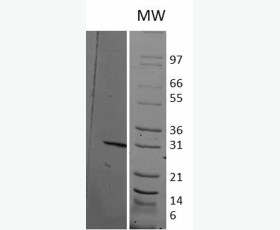Recombinant Human Cathepsin A/CTSA
| Product name: | Recombinant Human Cathepsin A/CTSA |
| Source: | Human Cells |
| Purity: | Greater than 95% as determined by reducing SDS-PAGE. |
| Buffer Formulation: | Supplied as a 0.2 μm filtered solution of 20mM PB,150mM NaCl,pH7.4. |
| Applications: | Applications:SDS-PAGE; WB; ELISA; IP. |
| Storage: | Avoid repeated freeze/thaw cycles. Store at 2-8 oC for one month. Aliquot and store at -80 oC for 12 months. |
| UOM: | 100ug/50ug/200ug/1mg/1g |
| Source | Human Cells |
| Description | Recombinant Human Cathepsin A is produced by our Mammalian expression system and the target gene encoding Ala29-Tyr480 is expressed with a 6His tag at the C-terminus. |
| Names | Lysosomal protective protein,CTSA,Carboxypeptidase C,Carboxypeptidase L,Cathepsin A |
| Accession # | P10619 |
| Formulation | Supplied as a 0.2 μm filtered solution of 20mM PB,150mM NaCl,pH7.4. |
| Shipping |
The product is shipped on dry ice/ice packs. |
| Storage |
Store at < -20°C, stable for 6 months after receipt. Please minimize freeze-thaw cycles. |
| Purity |
Greater than 95% as determined by reducing SDS-PAGE. |
| Endotoxin | Less than 0.1 ng/µg (1 IEU/µg) as determined by LAL test. |
| Amino Acid Sequence |
APDQDEIQRLPGLAKQPSFRQYSGYLKGSGSKHLHYWFVESQKDPENSPVVLWLNGGPGCSSLDG LLTEHGPFLVQPDGVTLEYNPYSWNLIANVLYLESPAGVGFSYSDDKFYATNDTEVAQSNFEALQ DFFRLFPEYKNNKLFLTGESYAGIYIPTLAVLVMQDPSMNLQGLAVGNGLSSYEQNDNSLVYFAY YHGLLGNRLWSSLQTHCCSQNKCNFYDNKDLECVTNLQEVARIVGNSGLNIYNLYAPCAGGVPSH FRYEKDTVVVQDLGNIFTRLPLKRMWHQALLRSGDKVRMDPPCTNTTAASTYLNNPYVRKALNIP EQLPQWDMCNFLVNLQYRRLYRSMNSQYLKLLSSQKYQILLYNGDVDMACNFMGDEWFVDSLNQK MEVQRRPWLVKYGDSGEQIAGFVKEFSHIAFLTIKGAGHMVPTDKPLAAFTMFSRFLNKQPYHHH HHH
|
| Background | Cathepsin A is active in cellular compartments called lysosomes. These compartments contain enzymes that digest and recycle materials when they are no longer needed. Cathepsin A interacts with the enzymes β-galactosidase and neuraminidase 1, which play a role in the breakdown of complexes of sugar molecules (oligosaccharides) attached to certain proteins (glycoproteins) or fats (glycolipids). Cathepsin A forms a complex with these two enzymes and directs their transport within the cell to the lysosomes. Within lysosomes, cathepsin A activates the enzymes and prevents their breakdown. |














